The test-teach-test (TTT) method evaluates students’ initial comprehension, teaches the necessary knowledge, and reassesses to determine progress. This strategy can be quite effective in a variety of learning situations, including self-teaching and peer teaching.
Here’s how it works and how I combined it with the Feynman technique to teach myself and my siblings.
Going through Test-Teach-Test method
1. Test: Initial Assessment
In the first stage, Test (Initial Assessment), students complete a task to determine their current understanding of the material. This could involve a grammar quiz, a writing prompt, or a spoken activity. The goal is to identify specific areas where students struggle. We usually implement this step like this:
- Conduct an initial task to determine the students’ current understanding of the material.
- Analyze the results to identify specific areas where students struggle.
- Keep a record of the identified weaknesses to tailor the upcoming instruction.
2. Teach: Targeted Instruction
During the Teach stage, I address the gaps identified in the first Test. This involves explaining concepts, correcting mistakes, and providing practice exercises. The instruction is focused on the errors observed, ensuring that students understand the material more clearly. Here’s how:
- Address the gaps identified in the initial assessment by explaining the concepts clearly.
- Provide corrective feedback on the mistakes observed in the initial assessment.
- Assign practice exercises focused on the areas of difficulty.
- Engage students with activities that reinforce the learned concepts.
3. Test: Reassessment
In the second Test, students retake a similar task to the initial one. This reassessment helps gauge their improvement and the effectiveness of the teaching stage. Comparing the results from the first Test and the second Test highlights areas of progress and any remaining challenges. This is how it works:
- Conduct a similar task to the initial assessment to measure students’ improvement.
- Compare the results of the initial and final assessments to highlight areas of progress and any remaining challenges.
- Keep a record of the improvements and remaining difficulties to inform future instruction.
My Personal Experience with TTT
I used TTT approach along with the Feynman technique and it significantly enhanced my learning process. Here’s how I applied it:
First Test:
- Grammar Quiz: I gave myself and my siblings a quiz on complex grammar topics to pinpoint our weaknesses.
- Writing Prompt: We wrote essays to identify common structural issues.
- Discussion: We had a group discussion to observe language use and fluency.
Teach:
- Explain Concepts: Using the Feynman technique, I simplified complex topics and taught them to my siblings. This involved breaking down concepts into simple terms and using analogies.
- Practice Exercises: We completed exercises targeting our identified weaknesses.
- Interactive Lessons: We engaged in activities like role-playing and flashcards to reinforce learning.
Second Test:
- Retake Quizzes: We retook similar quizzes to measure our improvement.
- Rewrite Essays: We wrote new essays on similar topics to compare structure and clarity.
- Follow-up Discussion: We had another discussion to check for improvements in fluency and language use.
Case Studies of TTT’s Efficiency
Sahar Shweiki, a researcher in An-Najah National University, did some case studies and interviews to see the effect of test-teach-test on English language writing skill. Interviews with teachers showed good attitudes toward the method, highlighting its effectiveness. A quasi-experimental study with ninth-grade students at Shu’fat Basic School for girls confirmed the TTT approach’s benefits, leading to recommendations for its greater use in teaching writing. Sahar Shweiki also offered further studies to explore the method’s potential in different contexts.

2 comments